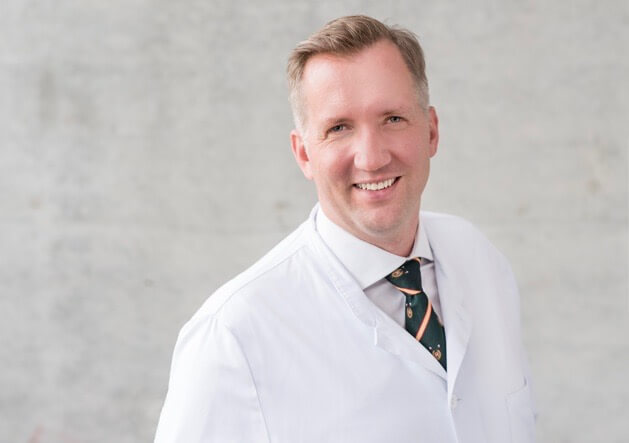
Sports injury? Treatments for knee and shoulder
Bruises, sprains, torn ligaments, tendons and muscles, broken bones and dislocations are common sports injuries.
Sports injuries and accidents
Anyone who does sport intensively knows that injuries cannot be avoided. In contrast to professional athletes, recreational athletes often "doctor" their injuries for a long time. In the case of injuries, a medical examination is always recommended.
Sports injury? Joint problems? Accident-related or chronic complaints?
Make your online appointment with Dr. Andreas Krüger:
Sports Injuries
Sports injuries typically occur during leisure and competitive sports. The major joints of the knee and shoulder are particularly affected, but also the ankle and wrist.
The most common sports injuries are bruises and sprains (40%), fractures and dislocations (35%) and tears of baths, tendons and muscles (25%): Frequent sports injuries and therapy.
Sports accidents occur during winter sports and ball sports, especially football. Every year, around 400,000 Swiss sportsmen and women are injured. Almost every fourth accident is a sports injury.
In rehabilitation, sports accidents differ from occupational and traffic accidents due to sport-specific accident mechanisms and special sports therapies.
400'000 sports injuries / year
Types of sports injuries
(Source: BfU-Statista 2017, Switzerland)
Clarification by specialized physician
Not every Sport accident needs surgery. Due to modern methods, such as splints for a torn ankle ligament, and conservative therapies, only 1-3 percent of sports accidents are operated on.
In the case of classic sports, occupational and traffic accidents, medical costs, any hospital stays and therapies are covered by the mandatory accident insurance (UVG) and optional supplementary insurance.
Conservative and surgical knee therapies
-

Advantages of being a private patient of Dr. Andreas Krüger
Your benefits at a glance : We focus on you as a person. Each treatment is individually tailored and personally validated by Dr. Andreas Krüger.
-

Sport accident knee
Injuries to the knee often occur during sport, as it is subject to high stress and is also very susceptible to injury. A sudden change of direction, an unfortunate fall or an overload can lead to torn ligaments, meniscus damage or strains.
-

Conservative knee therapy
Conservative knee therapy comprises non-surgical measures for the treatment of knee problems. The aim is to relieve pain, improve mobility and maintain or restore knee function.
-

Torn meniscus
A tear can be caused by sudden twisting movements, sports injuries or age-related wear and tear. Typical symptoms are pain, swelling, restricted movement or "jamming" in the knee.
-

Patella
The kneecap (patella) is a small, flat, triangular bone on the front of the knee. It sits in the tendon of the thigh muscle and protects the knee joint. At the same time, it improves the leverage of the thigh muscle, which is important for extending the leg.
-

Cruciate ligament rupture
A cruciate ligament rupture is a common injury in the knee joint in which one of the two cruciate ligaments - usually the anterior one - tears partially or completely. These ligaments stabilize the knee and prevent excessive movement of the tibia in relation to the thigh.
-

Knee arthrosis (gonarthrosis)
Knee osteoarthritis, also known as gonarthrosis, is a degenerative joint disease in which the cartilage in the knee joint slowly breaks down. As a result, the bones in the joint increasingly rub directly against each other, which can cause pain, stiffness and restricted movement.
-

Knee prosthesis for knee osteoarthritis
If conservative treatment methods such as physiotherapy, painkillers or injections no longer provide sufficient relief, a knee prosthesis can be an effective solution for advanced knee osteoarthritis.
Conservative and surgical shoulder therapies
-

Advantages of being a private patient of Dr. Andreas Krüger
Your benefits at a glance : We focus on you as a person. Each treatment is individually tailored and personally validated by Dr. Andreas Krüger.
-

Sport accident shoulder
A Sport accident to the shoulder often occurs during contact sports or due to falls. This can lead to bruising, strains, tendon tears or even shoulder dislocation.
-

Conservative shoulder therapy
Conservative shoulder therapy includes non-surgical treatment methods to relieve pain and restore mobility and function of the shoulder.
-

Shoulder tendon injury (rotator cuff)
An injury to these tendons - whether due to overloading, wear and tear or an accident - can lead to pain, restricted movement and loss of strength.
-

Shoulder instability (luxation)
Instability refers to excessive mobility of the shoulder joint in which the humeral head slips partially or completely out of the glenoid socket - a process known as dislocation.
-

Shoulder arthrosis (omarthrosis)
Omarthrosis is a wear and tear of the shoulder joint. The cartilage between the head of the humerus and the shoulder socket becomes increasingly worn, which can lead to pain, restricted movement and inflammation.
-

Shoulder prosthesis (artificial shoulder joint)
A shoulder prosthesis is an artificial joint replacement that is used in cases of severe damage or wear to the shoulder joint - often due to osteoarthritis, accidents or rheumatic diseases.
